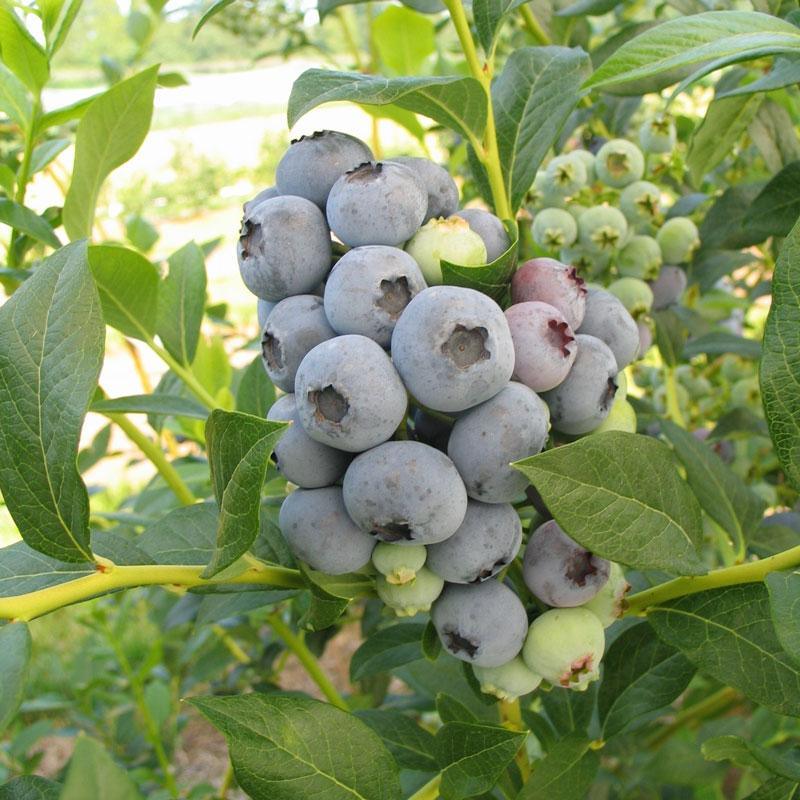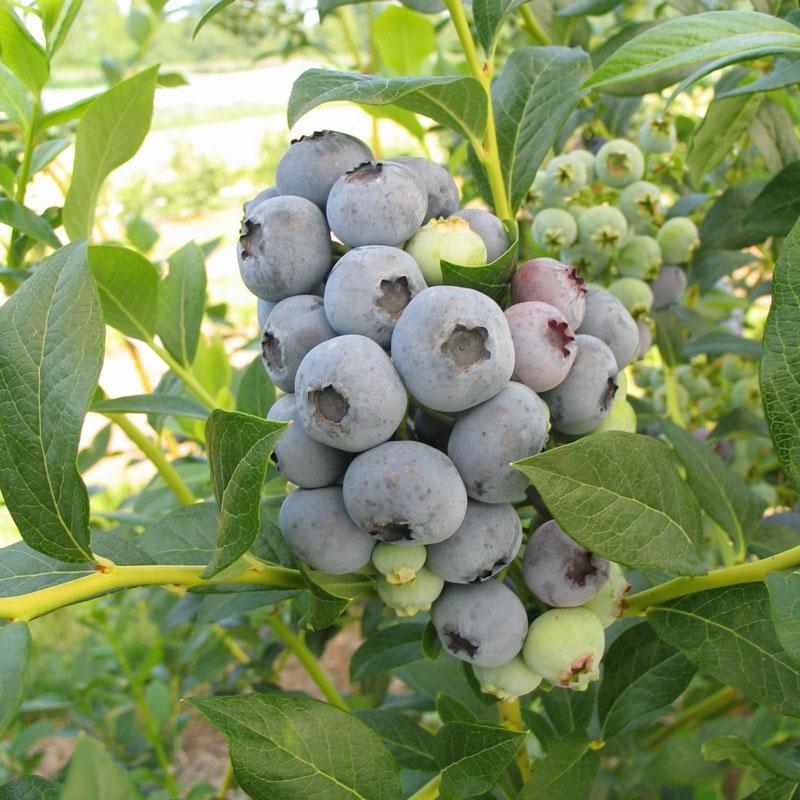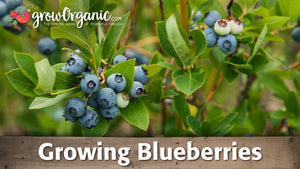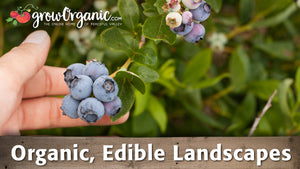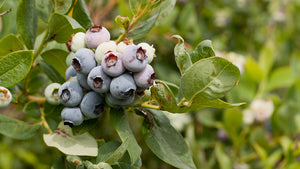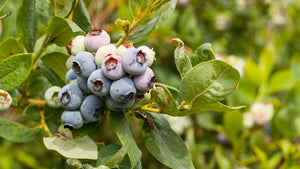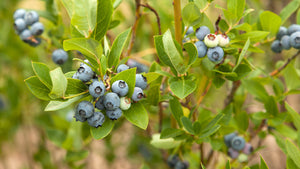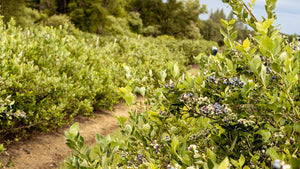Item Number: FV352
Blueberry - Bluecrop (Mid Harvest)
Blueberry - Bluecrop (Mid Harvest)
Most Widely Planted Blueberry in the U.S.
The Bluecrop variety is a Northern Highbush that is considered the best all around variety for adaptability, long production period, high yield fruit and disease resistance. There are other varieties with better ornamental value, but few perform better in the garden. Bluecrop is perhaps the most widely planted variety in the U.S. Good for eating fresh, preserving, baking, and freezing.
- Latin Name: Vaccinium Corymbosum sp.
- Plant Age: 1.5 years
- Zones: 4-7
- Chill Hours: 1000+
- Harvest: Mid-season
- Bush Habit: Upright, open bush reaching 4-6' tall with red foliage in fall.
- Fruit: Medium large, classically sweet, firm, crack-resistant, light blue berries with good sub-acid flavor.
Blueberries have long been cherished for their delicious flavor, vibrant color, and outstanding nutritional value. Among the diverse blueberry varieties available, Bluecrop stands out as a popular choice for gardeners and berry enthusiasts alike.
The Appeal of Blueberry Bluecrop:
Blueberry Bluecrop (Vaccinium corymbosum 'Bluecrop') is celebrated for its exceptional qualities:
Flavorful Berries: The hallmark of Blueberry Bluecrop is its sweet and slightly tangy berries. These delectable fruits burst with flavor, making them a favorite for fresh eating, baking, and preserving.
High Nutritional Value: Blueberries, in general, are renowned for their nutritional benefits. They are rich in antioxidants, vitamins, and fiber, contributing to a healthy diet and supporting overall well-being.
Abundant Harvest: Bluecrop blueberries are known for their prolific fruiting, producing an abundance of berries during the harvest season, which typically occurs in mid to late summer.
Easy Maintenance: Bluecrop bushes are relatively low-maintenance, making them suitable for both novice and experienced gardeners. With proper care, they can thrive and provide a consistent yield of tasty berries.
Ideal Growing Conditions:
To cultivate Blueberry Bluecrop successfully, it's essential to provide the right growing conditions:
Sunlight: Bluecrop blueberries thrive in full sun, receiving at least six hours of direct sunlight daily. Adequate sunlight ensures healthy growth and abundant fruiting.
Soil Quality: Well-drained, acidic soil with a pH level between 4.5 and 5.5 is essential for blueberry success. Amending the soil with organic matter, such as peat moss or compost, can help create the ideal pH and improve soil quality.
Proper Spacing: When planting Bluecrop blueberries, ensure adequate spacing between bushes to allow for air circulation and minimize competition for nutrients. A distance of three to five feet between plants is generally recommended.
Pruning and Maintenance: Regular pruning is essential to remove dead or diseased branches, encourage new growth, and maintain the shape of the bush. Additionally, consistent watering and mulching help retain soil moisture and prevent weeds.
Care and Maintenance:
Caring for Blueberry Bluecrop bushes involves a few key practices:
Watering: Blueberry bushes require consistent moisture, especially during the growing season. Keep the soil evenly moist, but avoid waterlogging, which can lead to root rot.
Fertilization: Provide balanced fertilizer with appropriate nutrients, following the recommended dosage and timing for blueberries. Generally, fertilization in the spring and late spring is beneficial.
Pest and Disease Management: Monitor your blueberry bushes for common pests and diseases, such as aphids, mites, or fungal infections. Early detection and prompt action can prevent infestations from becoming severe.
Netting: To protect your blueberry harvest from birds, consider using bird netting or other protective measures during the fruiting season.
Harvesting Blueberry Bluecrop:
Bluecrop blueberries are ready for harvesting when they turn a deep, rich blue color. Gently pick the ripe berries, leaving unripe ones for future harvests. Harvesting is typically done by hand, as the berries easily detach from the bush when they are fully ripe.
Blueberry Bluecrop is a delightful addition to any garden, offering a bountiful supply of sweet and nutritious berries that can be enjoyed fresh, baked into pies, transformed into jams, or incorporated into a variety of culinary creations. With proper care and attention to their ideal growing conditions, Bluecrop blueberry bushes can thrive and provide you with a steady supply of delectable berries, making them a valuable and rewarding addition to your garden and your table.
For more information, please enjoy our Growing Guide for planting and growing blueberries.


Check Your Zone Compatibility:
Compatible with your zone.
Growing Zone for
,

Our Guarantee To You
Since 1976, we've served our customers at every stage of growing. Please contact us at any time. We are happy to support and assist you.
Description
Description
The Bluecrop variety is a Northern Highbush that is considered the best all around variety for adaptability, long production period, high yield fruit and disease resistance. There are other varieties with better ornamental value, but few perform better in the garden. Bluecrop is perhaps the most widely planted variety in the U.S. Good for eating fresh, preserving, baking, and freezing.
- Latin Name: Vaccinium Corymbosum sp.
- Plant Age: 1.5 years
- Zones: 4-7
- Chill Hours: 1000+
- Harvest: Mid-season
- Bush Habit: Upright, open bush reaching 4-6' tall with red foliage in fall.
- Fruit: Medium large, classically sweet, firm, crack-resistant, light blue berries with good sub-acid flavor.
Blueberries have long been cherished for their delicious flavor, vibrant color, and outstanding nutritional value. Among the diverse blueberry varieties available, Bluecrop stands out as a popular choice for gardeners and berry enthusiasts alike.
The Appeal of Blueberry Bluecrop:
Blueberry Bluecrop (Vaccinium corymbosum 'Bluecrop') is celebrated for its exceptional qualities:
Flavorful Berries: The hallmark of Blueberry Bluecrop is its sweet and slightly tangy berries. These delectable fruits burst with flavor, making them a favorite for fresh eating, baking, and preserving.
High Nutritional Value: Blueberries, in general, are renowned for their nutritional benefits. They are rich in antioxidants, vitamins, and fiber, contributing to a healthy diet and supporting overall well-being.
Abundant Harvest: Bluecrop blueberries are known for their prolific fruiting, producing an abundance of berries during the harvest season, which typically occurs in mid to late summer.
Easy Maintenance: Bluecrop bushes are relatively low-maintenance, making them suitable for both novice and experienced gardeners. With proper care, they can thrive and provide a consistent yield of tasty berries.
Ideal Growing Conditions:
To cultivate Blueberry Bluecrop successfully, it's essential to provide the right growing conditions:
Sunlight: Bluecrop blueberries thrive in full sun, receiving at least six hours of direct sunlight daily. Adequate sunlight ensures healthy growth and abundant fruiting.
Soil Quality: Well-drained, acidic soil with a pH level between 4.5 and 5.5 is essential for blueberry success. Amending the soil with organic matter, such as peat moss or compost, can help create the ideal pH and improve soil quality.
Proper Spacing: When planting Bluecrop blueberries, ensure adequate spacing between bushes to allow for air circulation and minimize competition for nutrients. A distance of three to five feet between plants is generally recommended.
Pruning and Maintenance: Regular pruning is essential to remove dead or diseased branches, encourage new growth, and maintain the shape of the bush. Additionally, consistent watering and mulching help retain soil moisture and prevent weeds.
Care and Maintenance:
Caring for Blueberry Bluecrop bushes involves a few key practices:
Watering: Blueberry bushes require consistent moisture, especially during the growing season. Keep the soil evenly moist, but avoid waterlogging, which can lead to root rot.
Fertilization: Provide balanced fertilizer with appropriate nutrients, following the recommended dosage and timing for blueberries. Generally, fertilization in the spring and late spring is beneficial.
Pest and Disease Management: Monitor your blueberry bushes for common pests and diseases, such as aphids, mites, or fungal infections. Early detection and prompt action can prevent infestations from becoming severe.
Netting: To protect your blueberry harvest from birds, consider using bird netting or other protective measures during the fruiting season.
Harvesting Blueberry Bluecrop:
Bluecrop blueberries are ready for harvesting when they turn a deep, rich blue color. Gently pick the ripe berries, leaving unripe ones for future harvests. Harvesting is typically done by hand, as the berries easily detach from the bush when they are fully ripe.
Blueberry Bluecrop is a delightful addition to any garden, offering a bountiful supply of sweet and nutritious berries that can be enjoyed fresh, baked into pies, transformed into jams, or incorporated into a variety of culinary creations. With proper care and attention to their ideal growing conditions, Bluecrop blueberry bushes can thrive and provide you with a steady supply of delectable berries, making them a valuable and rewarding addition to your garden and your table.
For more information, please enjoy our Growing Guide for planting and growing blueberries.
About Blueberries: Delicious, exceptionally nutritious, and high in bioflavanoids. Consider climate suitability, ripening season and fruit size when selecting varieties and include at least two different varieties for cross-pollination and fruiting (any two varieties will do, regardless of ripening time). Grow in acidic, well-drained soil. Cottonseed meal is an excellent fertilizer for blueberries along with good quality compost and peat moss.
Browse our collection of blueberries.
Shipping Information
Shipping Information
Cannot ship to the following states: HI, AK, PR, GU, VI
Cannot ship via USPS.
Cannot ship via SmartPost.
Shipping Weight: 3.0 lb
Dimensions: 14.0"L x 3.0"W x 3.0"H
Features
Features
- Container Compatible
- Long-Lived
- Suited to Cold Climates
Characteristics
Characteristics
Planting & Care
Planting & Care
Useful Information
Useful Information
Guarantee
Guarantee
Limited Dormant Tree & Plant Guarantee
* Claim deadline is June 15th
We guarantee that your dormant tree or plant will arrive in good, viable condition. If your tree arrives in substandard condition, notify us within 3 days of delivery. Please email pictures of the box, inside packaging, the tree and its roots to helpdesk@groworganic.com. We will investigate your claim and process a request to exchange or refund the damaged product.
If your dormant tree or plant has not grown new leaves by June 15th, you may be eligible for our Limited Dormant Tree & Plant Guarantee. This guarantee provides for a store credit for the purchase price of the tree, excluding shipping. Please see the Instructions below.
Important Dates:
- April 1st Dormant trees/plants must be planted in the ground
- May 15th Perform scratch test, if no new leaves have grown
- June 15th Deadline to apply for a dormant tree/plant credit
All required documentation must be received by June 15th for your claim to be considered. Claims or documentation received after June 15th will be denied, without exception. Instructions listed below
Terms and Conditions
We cannot guarantee that your tree or plant will remain alive and healthy after it is received, or bear fruit as there are too many variables in your environment that are beyond our control (i.e. soil preparation, weed and pest control, proper irrigation, chill hours, compatible hardiness for your growing zone, proper choice of pollinator, extreme weather, rodent damage, disease, etc.).
We cannot guarantee that we will be able to provide a replacement tree/plant of the same species either that same growing season or in future years. Customers are responsible for all shipping fees associated with replacement trees and plants.
If we determine that the tree you purchased directly from us is not viable, we will issue you a store credit (not a refund) for the purchase price of the affected dormant tree or plant. Shipping is not included in the dormant tree/plant guarantee. Store credits can be used to purchase any product we sell and are valid for use only until July 1st of the following year.
Historically, 98% of our dormant trees and plants grow and thrive when they have been cared for and planted using our growing guides. Dormant trees and plants must be planted in the ground by April 1st in order to be eligible for credit. If the ground in your area is still frozen solid, you may temporarily plant your tree or plant in a pot.
Potted, non-dormant trees or plants are excluded from this guarantee as they are not dormant at the time of shipment. Evergreen trees such as citrus, avocado and olive trees are not available for credit under the Dormant Tree and Plant Guarantee.
Instructions
We guarantee that your dormant fruit tree or plant will leaf out, if you care for it according to our growing guides. In the unlikely event that your dormant tree or plant does not have leaves by May 15th, follow these simple steps to apply for a store credit:
Before you call or email, please perform a “scratch test” to determine if the tree or plant is still alive. This video shows how to check for live tissue under the bark. Scratch tests need to be done a few inches above and below the graft.
Green Cambium Layer / Living Trees
If the cambium layer under the bark is green, give your tree a little more time. It is still alive, but hasn’t come out of dormancy yet. Check to make sure that it is getting the right amount of deep root water, enough sunlight and that the weather is warm enough for that type of tree/plant to come out of dormancy. Every tree has its own personality and will come out of dormancy at different times. Be sure to submit the required documentation listed below by June 15th, if it doesn’t grow leaves.
Brown Cambium Layer / Dead Trees
If the scratch test shows a brown cambium layer or if your dormant tree/plant doesn’t have leaves by June 1st, please email us at helpdesk@groworganic.com. All required documentation listed below must be received by June 15th for your claim to be considered. To be considered for the guarantee claim, all required documentation must be received by June 15th. Incomplete submissions will be denied.
Required Documentation
- Order number
- Name of dormant tree/plant and the quantity affected
- Photos of each tree or plant showing:
- The roots (tree or plant must be pulled out of the ground)
- The scratch test areas
- The entire tree/plant
We reserve the right to not issue credit for items that have already been replaced. We also reserve the right to require photographic evidence that the tree/plant was not killed by root rot, rodent or mechanical damage.
Share
